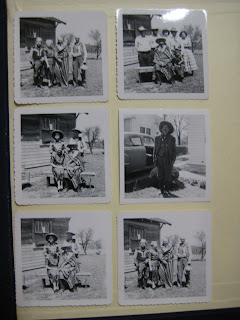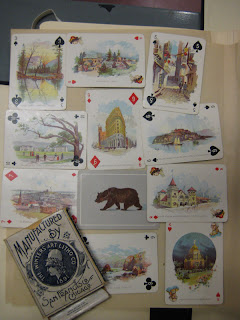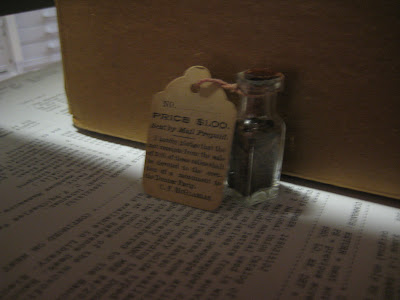
"Every Dog (No Distinction of Color) Has His Day."
From Scrapbooks on Chinese immigration collection, Banc MSS 89/151c Volume 1.
-- D. Miller.


-- D. Miller.

June 1, 1921. Unalaska.
One of the ships brought in some bear meat and we had it for dinner. It tasted like an auto tire. The doctor said he hoped the natives would not break the plaster cast he put on. Parhem (sic) suggested that we might make the steward make one out of pie crust which he could not break. Perham thought bear meat pretty good. He thought it had been fattened on Eskimos.
June 22, 1921. Siberia.
We are here for some shipwrecks. We picked up a sorry lot of pirates this morning. They have been wrecked and have been living on walrus meat for a couple of years in Siberia. I think one has scurvy. The men tell us terrible things about the Communists (sic) system there. I think it is a good place to stay away from...
The Bear at Emma Harbor, Siberia.
from letter of July 1, 1921. Emma Harbor, Siberia.
The American Museum of Natural History man landed some of his stuff here today and the Russians raised a terrible fuss and said he could not stop there so we took it aboard again. Then they objected to our magnetic observations and they didn't want an American war-ship in their port without permission of their gov (sic). The Capt. asked who was their gov. (sic) and they said they didn't know. He said if we were at peace we had a right to stay here and if at war we would stay anyway. We will clean our boilers here because we have to. the ice is drifting out of the bay and the water is very smooth. In it are reflected the high mountains, covered with patches of snow and ice.
Lubte Harbor, Siberia. This is a rock on which chunks of seal meat are suspended to be beyond the reach of the numerous dogs.
July 11, 1921. Off East Cape
...Tell the boys I am in the Polar Sea now near where Santa Claus has his toy factory. I shall try to get around and see him soon.
(Below) This man is a Siberian native. Siberians are called Chuchis (sic). They are happy but dirty...
(Part of Todd's journey was in the Bering Strait going between Alaska and Siberia; north of Bering Strait is the Chukchi sea. Some Chukchi, natives of the Arctic and SIberia, are pictured above. For more information on the Chukchi people see http://www.allthingsarctic.com/people/chukchi.aspx)
Your poor lonely hubby.
July 21, 1921. St. Michael's.
...Last night the army invited us all to some athletic stunts and Capt. Cochran said we better go to make a representation from the ship so I went. We had a little supper served by one of the officers' wives. What do you think we had? Brownies. I ate so many I was ashamed. Next day, the Captain is having a dinner for the army crowd and I am invited. I stood watch from 5:30 to 12 this morning. I am to blossom out into society tonight.
Aug. 2, 1921. Point Hope, Alaska.
... I have been chatting with one of the natives. Somebody gave him a quarter and he told me that man "was his very good friend." So I said I was his very good friend too and to demonstrate it I gave him a cup of coffee and some trinkets. He said his name was Killbear. We had quite a talk. ... He said he had to work very hard hunting to feed his children. I said I had to work very hard to feed mine too, but he seemed to think that a joke.
Aug. 15, 1921. Demarkation Point, Alaska.
... It is a beautiful night. We are anchored in open water about a mile from the beach right on the boundary. Between us and the shore is a lot of heavy barrier ice grounded. When the boat goes ashore someone has to go aloft on the ship and pilot the boat by signal through the ice... Tonight the ship is pitching gently in a little swell which jolts the masses of ice together and there is a tremendous crunching and grinding roar along the ice. A very full red moon is just over the mountains to the southward.
(Left) Here I am steering the boat through the ice at Demarkation Point.
August 18, 1921. Point Barrows, Alaska.
(Right) These are some aged Eskimos at Point Barrows. The woman is said to be over 100 years old.
August 1921, Alaska (possibly point Barrows).
Beautiful parka made and worn by an eskimo woman.
In the Arctic, Alaska.
To-Look cleaning polar bean skin in her hut.
The last letter in this series is from August 30, 1921. An entry from the manuscript's compiler and later wife of Capt. Clement Todd, Bernice Jameson Todd, indicates that "the ship after finishing at Unalaska sailed for Seattle and later to Oakland (in October) ... Clement and I met in Berkeley where we spent the winter together." Clement J. Todd made his next voyage to Alaska on the Coast Guard Cutter Bear in May 1922, where the letters continue.
-- D. Miller.
 These photographs feature Eaton, his biographer, Eva Gillhouse, Rolla Goodnight, and a 104-year-old Indian chief and his family. The snapshots were taken at the Chief's home in Oklahoma in May 1952.
These photographs feature Eaton, his biographer, Eva Gillhouse, Rolla Goodnight, and a 104-year-old Indian chief and his family. The snapshots were taken at the Chief's home in Oklahoma in May 1952. The Jeffrey Schweitzer papers contain the mementos he collected from a number of international fairs. These include a nifty deck of illustrated playing cards from the San Francisco Mid-Winter Exposition, 1884. This particular deck of "Midwinter Fair and Pacific Coast Playing Cards" was manufactured by The Winters Art Litho Co., San Francisco/Chicago in 1891; they have an enamel finish. In addition to illustrations of the Mid-Winter Expo, the cards depict scenes from the Pacific Coast, from Washington State to Los Angeles. Bay Area scenes include San Francisco's Chinatown, Golden Gate Park and Alcatraz. The deck includes a card of the University of California or, as the card reads: California State University Berkeley. By the time Schweitzer graduated from the University of California in 1907, the campus he walked would have looked significantly different than the one depicted here as the 10 of clubs.
The Jeffrey Schweitzer papers contain the mementos he collected from a number of international fairs. These include a nifty deck of illustrated playing cards from the San Francisco Mid-Winter Exposition, 1884. This particular deck of "Midwinter Fair and Pacific Coast Playing Cards" was manufactured by The Winters Art Litho Co., San Francisco/Chicago in 1891; they have an enamel finish. In addition to illustrations of the Mid-Winter Expo, the cards depict scenes from the Pacific Coast, from Washington State to Los Angeles. Bay Area scenes include San Francisco's Chinatown, Golden Gate Park and Alcatraz. The deck includes a card of the University of California or, as the card reads: California State University Berkeley. By the time Schweitzer graduated from the University of California in 1907, the campus he walked would have looked significantly different than the one depicted here as the 10 of clubs.


Talk about scandalous finds! The tags tied to the items indicate that someone was selling the vials as souvenirs, and promised to later use the proceeds to build a Donner Party memorial. Whether the souvenir seller was responsible or not, today Donner Memorial State Park boasts a Pioneer Monument. The Donner Party's Murphy family cabin site, from which the tooth came, is also available to visitors. Although a human baby tooth is a rare find indeed in the manuscript archives, the housing of these items was truly beautiful to behold.
Some Donner Party collections that can be viewed at the Bancroft Library include the Patrick Breen Diary, BANC MSS C-E 65:15 (also viewable online through the library catalog) and Material relating to the Greenwood family, [ca. 1888-1967], BANC MSS C-B 966.
-- D. Miller, original posting date May 23, 2008.